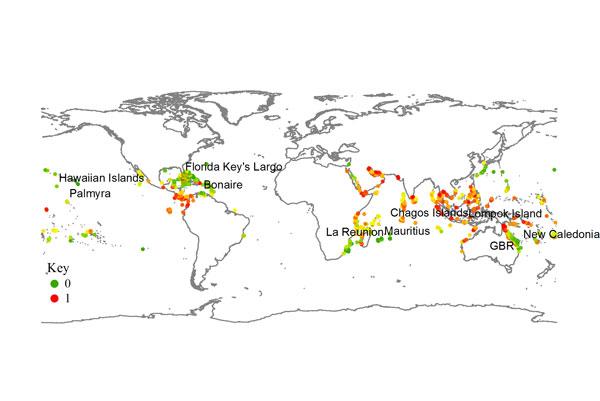
New Coral Map Ranks Reefs Most at Risk

The world's coral reefs face a multitude of threats, from rising ocean temperatures to overfishing. A new map aimed at aiding coral conservation has been developed that points out the reefs that are most and least at risk.
The map, and the study that led to it, say researchers, will help to conserve some of the world's most important coral reefs by identifying reef systems where biodiversity is high and stress is low, ecosystems where management has the best chance of success. [See the coral stress map here.]
"Coral reefs around the globe are under pressure from a variety of factors such as higher temperatures, sedimentation and human-related activities such as fishing and coastal development," said Joseph M. Maina of the Wildlife Conservation Society, one of the groups that contributed to the study.
Using an array of publicly available data sets from satellites and a branch of mathematics known as fuzzy logic, which can handle incomplete data on coral physiology and coral-environment interactions, the researchers grouped the world's tropical coral reef systems into clusters based on the degree of their stress exposure and the factors that reinforce and reduce these stresses on the coral reefs .
The first cluster of coral regions Southeast Asia, Micronesia, the Eastern Pacific and the central Indian Ocean is characterized by high radiation stress (sea surface temperature, ultra-violet radiation and doldrums weather patterns with little wind) and few stress-reducing factors (temperature variability and tidal amplitude). The group also includes corals in coastal waters of the Middle East and western Australia (both regions have high scores for reinforcing stress factors such as sedimentation and phytoplankton, tiny marine plants that can bloom and block out other forms of sea life).
The second cluster including the Caribbean, Great Barrier Reef , Central Pacific, Polynesia and the Western Indian Ocean contained regions with moderate to high rates of exposure as well as high rates of reducing factors, such as large tides and temperature variability.
Overall, stress factors such as surface temperature, ultra-violet radiation and doldrums were the most significant factors, ones that ecosystem management has no control over. What is controllable is the mitigation of impact from humans that reinforce radiation stress and where managers decide to locate their protected areas.
Sign up for the Live Science daily newsletter now
Get the world’s most fascinating discoveries delivered straight to your inbox.
"When radiation stress and high fishing are combined, the reefs have little chance of surviving climate change disturbances because they both work against the survival of corals that are the foundation of the coral reef ecosystem," said Caleb McClennen, director of the Wildlife Conservation Society's Marine Program. "The information will help formulate more effective strategies to protect corals from climate change and lead to improved management of reef systems globally."










